Comparison of Hydraulic and Industrial Filtration Systems
Filtration equipment designed for hydraulic systems are sometimes
used for industrial liquid filtration applications and likewise
there are overlaps in applications for industrial filtration
equipment within hydraulic systems. Both types of filters remove
contaminants from liquids, however they are designed with different
priorities and considerations based on the specific needs of
hydraulic systems and industrial processes.
Typical examples of hydraulic systems which require the specialized hydraulic filter designs include:
-
Hydraulically actuated machinery (presses, molding machines, and robotics)
-
Lubrication systems (gearboxes, turbines, rotating machinery, and hydraulic systems)
-
Cooling systems (circulation of a heat transfer liquid through heat exchangers)
In all cases the purpose is to protect equipment from contaminants
fouling, damaging or impeding the performance of downstream
processes.
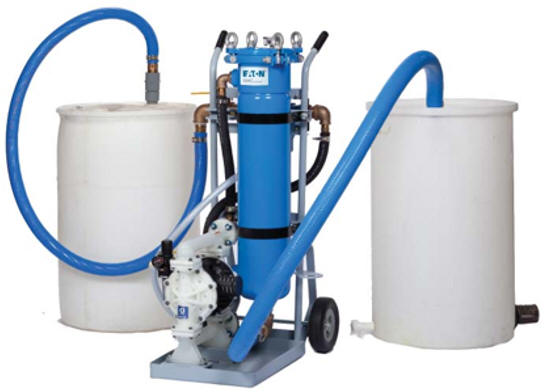 Industrial filtration equipment generally has a
broader application base, having configurations adaptable to
different viscosities, temperatures and much higher flow rates than
applicable to hydraulic systems. The area of overlap, where
industrial filtration utilized for hydraulic liquids are typically
for preconditioning or waste filtration. Initial filling of
hydraulic systems, including transfer from tankers and into/out of
barrels, often involve a coarse level of filtration to remove
particulates that are accidently introduced into the liquid.
Industrial filtration equipment generally has a
broader application base, having configurations adaptable to
different viscosities, temperatures and much higher flow rates than
applicable to hydraulic systems. The area of overlap, where
industrial filtration utilized for hydraulic liquids are typically
for preconditioning or waste filtration. Initial filling of
hydraulic systems, including transfer from tankers and into/out of
barrels, often involve a coarse level of filtration to remove
particulates that are accidently introduced into the liquid.
When the hydraulic liquid is worn out or replaced, it is often
recovered and filtered for recycling or disposal, which could entail
using industrial filter bag equipment for fine filtration and
perhaps incorporating rare earth magnets to efficiently recover
metal fines.
Particle Size and Contaminant Type: Hydraulic
filters are designed to remove smaller particles and contaminants,
such as dirt, debris, and metal shavings which damage hydraulic
components like pumps, valves, and actuators. Industrial liquid
filters focus on removing a broader particle range from 1 to 800
microns for sediments and impurities that can affect water quality
or the performance of industrial processes.
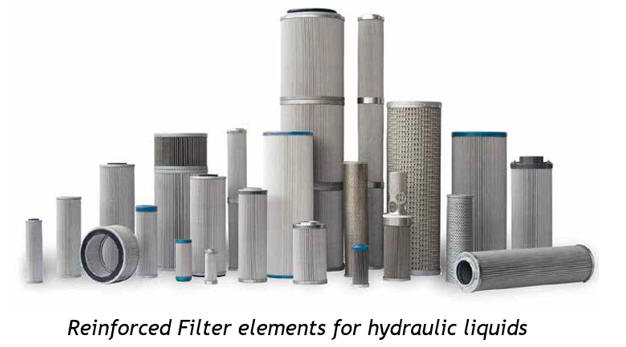 Pressure Ratings: Hydraulic systems typically
operate under high pressures, 145 to over 20,000 PSIG, requiring
filters that can withstand these pressures without failure.
Hydraulic filters are engineered to maintain their integrity and
filtration efficiency under these high-pressure conditions.
Industrial water and fluid filters may not need to withstand such
high pressures and may be designed for lower pressure environments.
(typically, 30 to 150 PSIG)
Pressure Ratings: Hydraulic systems typically
operate under high pressures, 145 to over 20,000 PSIG, requiring
filters that can withstand these pressures without failure.
Hydraulic filters are engineered to maintain their integrity and
filtration efficiency under these high-pressure conditions.
Industrial water and fluid filters may not need to withstand such
high pressures and may be designed for lower pressure environments.
(typically, 30 to 150 PSIG)
Fluid Compatibility:
Hydraulic filters are designed specifically for hydraulic liquids,
which often include additives and properties tailored to lubricate
and protect hydraulic system components. These filters need to be
compatible with various hydraulic liquids, including mineral oils,
synthetic liquids, and water-based liquids. Industrial water and
liquid filters may need to handle a broader range of fluids,
including water, chemicals, oils, and solvents, necessitating
different materials and construction methods.
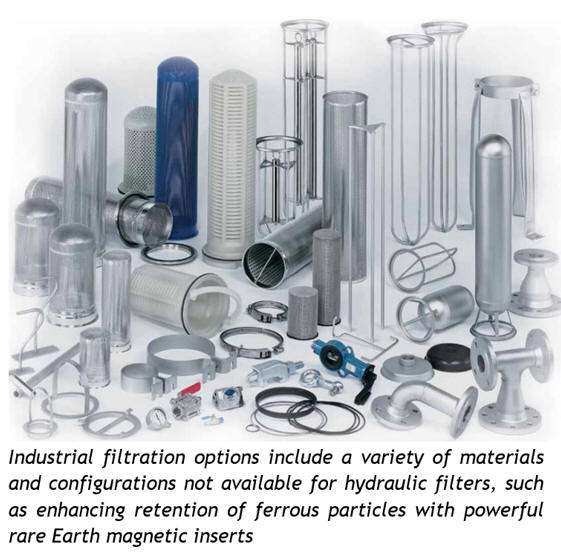 Filtration Efficiency and Micron Ratings: Hydraulic
filters typically have higher filtration efficiency and lower micron
ratings (3 to 130 microns) compared to filters used for industrial
water and liquids. This is because hydraulic systems require cleaner
liquid to ensure the proper functioning and longevity of hydraulic
components. Some hydraulic systems are so sensitive to contamination
that monitoring equipment is installed to accurately determine the
solid contamination, particle size distribution, water saturation,
and temperature of hydraulic liquids in real-time.
Filtration Efficiency and Micron Ratings: Hydraulic
filters typically have higher filtration efficiency and lower micron
ratings (3 to 130 microns) compared to filters used for industrial
water and liquids. This is because hydraulic systems require cleaner
liquid to ensure the proper functioning and longevity of hydraulic
components. Some hydraulic systems are so sensitive to contamination
that monitoring equipment is installed to accurately determine the
solid contamination, particle size distribution, water saturation,
and temperature of hydraulic liquids in real-time.
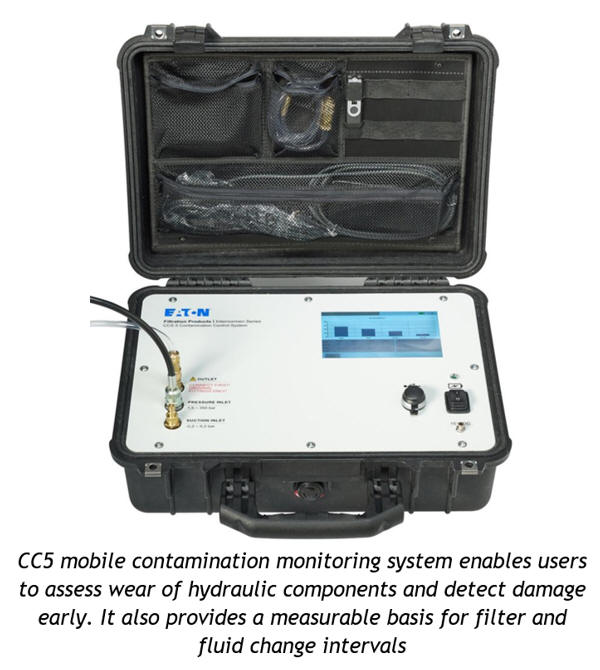 While there are industrial filter bags, cartridges and screens for ≥
½ micron retentions, they are often limited to differential
pressures <30 PSI and are “oversized”, meaning they are inherently
designed for higher flow rates then typical of a hydraulic system.
While there are industrial filter bags, cartridges and screens for ≥
½ micron retentions, they are often limited to differential
pressures <30 PSI and are “oversized”, meaning they are inherently
designed for higher flow rates then typical of a hydraulic system.
System Integration and Maintenance: Hydraulic filters are often
integrated into hydraulic systems in a way that facilitates easy
access for maintenance and replacement. They may be designed to
withstand vibration, shock, and other conditions commonly
encountered in heavy equipment and construction environments.
Industrial water and liquid filters are often integrated into
different types of systems, such as water treatment plants or
manufacturing processes, where they are independently supported or
supported by the pipeline and not specifically designed for
vibration and shock associated with mobile equipment.
Industrial Applications for Hydraulic Filters
There are some industrial applications which benefit from fine
filtration of particles under high pressure for which a hydraulic
filter could be utilized, such as machining systems which use high
pressure water for cutting or high-pressure coolant for lubrication,
cooling and material ejection.
Water jet cutting systems use
high-pressure water to cut through metal, stone and composite
materials. The sapphire orifices used to apply the water are very
fine and as such they are susceptible to wear and clogging from
contaminates in the water supply. Filters designed for hydraulic
systems are used for such applications due to their high-pressure
ratings and fine filtration efficiency.

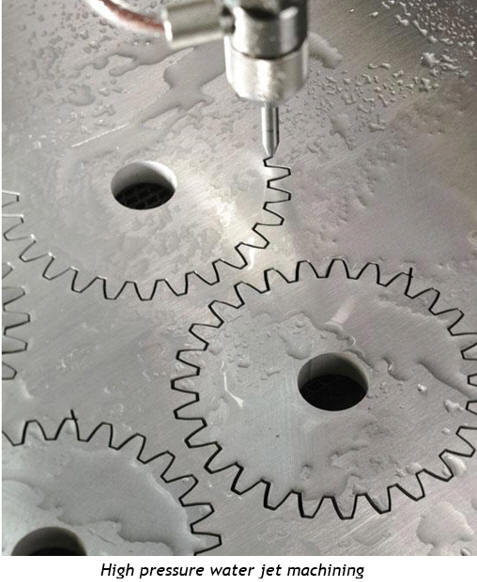 High pressure machine tool coolant applications refer to using an
oil or water-based liquid for lubrication, cooling and ejection of
cut material drilling, milling and lathing applications. The used
coolant is filtered prior to reuse to extend the wear-life of pumps,
rotary unions and tooling; it also has an added benefit of improving
surface finish and supports faster operation of the machinery. Such
systems often utilize industrial style bag filtration systems to
retain large quantities of solids >50 microns on the suction side of
the high-pressure pump system and a finer hydraulic filter to
“polish” or remove particle <50 microns to protect downstream
components. Depending upon the process, some machining applications
rely solely on filtration on the high pressure (discharge) side of
the pump system although most perform the filtration on the (lower
pressure) inlet side of the pump system.
High pressure machine tool coolant applications refer to using an
oil or water-based liquid for lubrication, cooling and ejection of
cut material drilling, milling and lathing applications. The used
coolant is filtered prior to reuse to extend the wear-life of pumps,
rotary unions and tooling; it also has an added benefit of improving
surface finish and supports faster operation of the machinery. Such
systems often utilize industrial style bag filtration systems to
retain large quantities of solids >50 microns on the suction side of
the high-pressure pump system and a finer hydraulic filter to
“polish” or remove particle <50 microns to protect downstream
components. Depending upon the process, some machining applications
rely solely on filtration on the high pressure (discharge) side of
the pump system although most perform the filtration on the (lower
pressure) inlet side of the pump system.
Please remember us the next time you have a challenging application and let us put our >30 years of experience to work for you!




